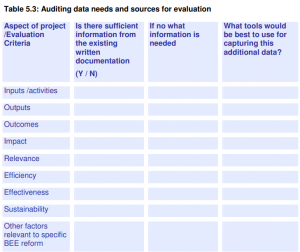Designing an M&E strategy is usually an iterative process that involves numerous different iterations of the strategy. The tasks of M&E design are discussed here. The program manager will not be in charge of all tasks, but he or she will need to comprehend, influence, and maybe make the ultimate choice. Prior to putting together a budget and putting it all together into a formal plan, there are usually six variables to consider in M&E design. The sections that follow go over each of the six areas of preparation.
The six factors to consider and sources of information
- Questions
Determine the important questions that the M&E will ask and answer.
Examining the project Log Frame or an analogous project planning document is usually the simplest approach to determining critical questions. Making it easier and ‘better’ to register a firm is a typical question for a business regulatory simplification initiative. For example:
- Monitoring questions:
- How many steps does it take to register a firm now compared to following the reforms?
- How many and which government agencies should be involved in the reform process?
- How many and which government officials will need to be taught to implement the reform’s changes?
- Evaluation questions:
- Have laws and regulations changed as a result of reform efforts?
- Has the cost of registering for each procedure altered as a result of the reform?
- Has the length of time it takes to register changed?
- Impact questions:
- – Are more businesses registering as a result of the reform?
- – Are these new or established (informal) firms that are registering for the first time?
The PM quick checklist
– Is there a log frame for this project?
– What lessons have been learned from similar BEE changes in the past?
– What are the most important questions I should address in my M&E?
– What will I need to accomplish in order to combine program management with the M&E cycle?
- Approach
Agree on the overall M&E process and approach.
Monitoring and assessment are distinct, although they are both necessary and complementary. The most important factor to examine for monitoring is whether the project plan incorporates management methods and procedures that will assure the continuous collection, recording, and assessment of project inputs, activities, and outputs.
The goal of evaluating results and determining impact should be to ‘prove’ or ‘validate’ learning and have the ability to share it. The evaluation strategy and methodology chosen must be appropriate for the project’s size and scope, as well as the resources and timeline available. It is critical, according to best practices, to make informed decisions about methodology and approach at the earliest stage of project design.
The PM quick checklist
- Can I choose the best M&E approach and methodology with confidence?
- What have prior designs taught me?
- Can I build a strong baseline using existing data or do I require primary data?
- Do I know who to sample and how to do so?
- Do I know who to turn to for help and advice?
- Indicators
Select the proper indicators.
Following the identification of important questions, indicators and then targets must be developed. These are the things that will be measured in order to show whether or not the project is accomplishing its goals.
Remember to identify indicators for all parts of the project’s activity, from activities to the project’s overarching purpose or goal.
The PM quick checklist
- Does my company employ key performance indicators (KPIs)?
- Do I have a combination of quantitative activity and process indicators, both basic and customized?
- Is it possible to compare the outcomes to those of other similar projects?
- Is it possible to disaggregate for diversity?
- Data collection
Select data collection and analysis tools and instruments.
A short assessment will reveal what information is available through current documents at this point. Plans can be decided upon for what needs to be generated through project data collecting and how best to do it. A simple audit sheet for this is shown below.

- Timeframes
Plan out a timeline with specific milestones.
Planning for M&E work necessitates PM skills. Data must be collected at various periods throughout the project: before, throughout, and after the project’s completion. It’s a good idea to put things together as a timeline, such as a gantt chart (using software such as Microsoft Project). A gantt chart can be used to determine resource requirements at specific times, schedule work, and track progress. A gantt chart can be used as a checklist by both the M&E and implementation teams, and it should be utilized in conjunction with the overall project timeline. A review of the minimum and maximum timelines is useful when there are more complex needs, taking into consideration the time required to tender, prepare documentation for hired consultants, and designate time for briefings and reporting. Arrangements for reporting should also be made clear. It’s easy to underestimate the amount of effort required to ensure that all partners and stakeholders are properly engaged.
Multi-component programs may follow a completely distinct timetable, spanning years and involving multiple development partners. It’s not uncommon to find that an M&E project in and of itself is necessary to prepare and plan for M&E. The establishment of a framework, as well as all the institutional components that surround it, is a major feature of this endeavor. This includes establishing a reporting framework, including agencies in data collecting, increasing capacity, collaborating with local survey firms, and, most importantly, involving the private sector and using M&E outcomes to gain support for reform.
The consequences of the PM’s absence from M&E planning are expected to have a negative influence on the proposed timelines.
The PM quick checklist
- Can I explain the project’s milestones in terms of M&E requirements?
- Who needs to know when the evaluations will be completed?
- Will there be a variety of stakeholders and development partners?
- How long will it take to enlist the help of outside experts?
- Who will sign off on communication reports and documentation?
- Resources
Identify the people and other resources needed to complete the M&E.
When stages 1–5 are completed, it will be evident what type and degree of skills and experience would be required to complete the proposed M&E work. It is important to note that resources for disseminating discoveries and experiences are not always available, and it is pointless to have established all of the above if there is no method to demonstrate success.
The PM quick checklist
- Which members of the internal M&E team will be assigned to this project?
- Does any capability building need to be done in order for this to happen?
- How will the findings and lessons learned be shared?
- What tasks should an external consultant – local or foreign – perform?
- Where are the funds going to come from?
Once the above has been decided upon, the tasks and responsibilities for partners, internal stakeholders, and external consultants must be documented in some sort of project management structure for the M&E activity.
Putting together an M&E budget
The cost of M&E is becoming more of a concern. As development organizations look for more reliable ways to measure development outcomes, concerns regarding the costs and efficiency of M&E surface. Cost is frequently cited as a barrier to doing serious assessment efforts beyond the conventional end-of-project wrap-up. The idea is that resources spent on M&E would be better spent on the aid intervention itself, maximizing the benefits to people who are being helped.
The overall budget for M&E activities and their scope for every specific project must be proportional to the volume and scope of the humanitarian intervention being evaluated. Larger, more complex projects involving a large number of businesses and/or people will typically have more extensive, and thus more expensive, M&E systems. Similarly, because new ways must be developed, an innovative project may necessitate additional effort and resources for M&E. Similarly, a pilot activity may entail more intensive M&E work over a shorter time period in order to determine whether it should be ‘rolled out’ more widely.
How much should be allocated?
After the components of the M&E design have been determined, everything must be costed and combined into an M&E budget. This, too, may be an iterative process. The budget must strike a balance between available M&E resources and the requirements of the M&E framework and plan that have been developed.
What does an M&E budget typically include?
- Human resource – internal staff, including any training needed.
- External consultants.
- Materials, equipment.
- Travel.
- Data collection (baseline and follow-up).
- Data analysis.
- Seeking and managing stakeholder involvement.
- Reporting and communicating findings, internally and externally.
- Printing.
This will need to be evaluated if the methodology, tools, and staffing options chosen exceed the given budget. Different, more restrictive decisions about the procedures and technologies to be employed must be made, or more resources must be negotiated. The budget should be compared to three different things:
- The expenditures of other similar monitoring and evaluation operations.
- The monitoring and evaluation of similar projects.
- Following the ‘rules of thumb,’e., a maximum of 5% of the total project budget, except for experimental or more substantive initiatives, where a guideline of closer to 10% is usually offered.
Who manages the budget?
The budget may not be administered in a single location or by a single person. As previously mentioned, several of these M&E tasks (especially monitoring) are part of the routine gathering of data on the reform’s activities and outcomes and can be carried out by partners or the project team. Computer programs or training, on the other hand, may be required to enable accurate and timely data collection and recording. This money could be used for something else. Instead of funding from the program, an impact evaluation may be required and paid for by a single donor. When creating a budget and reporting ‘rules of thumb,’ all of these elements must be taken into account.
M&E budgets have been ‘outline budgets,’ particularly concerned with evaluation activities and focusing on covering the expenditures of end-of-project assessment and external consultant contributions. Because of the growing emphasis on ‘proving’ development results and the creation of more detailed and sophisticated M&E procedures, more detailed M&E budgets and plans are required.
The PM quick checklist
- Does my company have a budgeting rule of thumb for M&E?
- Will other stakeholders be involved in some of the M&E activities?
- Did I include a budget line item for distribution?
- Who is in charge of which components of the budget?
To learn more about the project cycle of Monitoring & Evaluation (M&E), enroll for our course in Monitoring, Evaluation, Accountability, & Learning (MEAL) today for a 10% discount!
![]()





